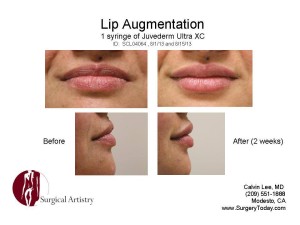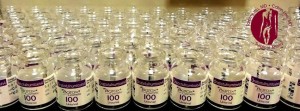
Picture is not of a an actual lip augmentation patient
Lip Augmentation
I perform lip augmentation with fillers such as Restylane and Juvederm ultra. I have occasionally used Juvederm Ultra plus for more dramating lip augmentation effects. This write-up serves it’s purpose for me to put down on paper some thoughts flying around my head regarding excellent lip augmentation. My thoughts on Cannulas for Lip Augmentation. Much of the info here is considered off-label FDA usage. Nothing here is meant to be personalized medical advice – just a generalized discussion here.
Does Lip Augmentation Hurt?
The procedure is done in my office in Modesto, CA. There is no IV sedation or pill sedation or general anesthesia. There are options of numbing cream, ice, nerve blocks, mucosal blocks, and lidocaine within the product. Some lip augmentation patients choose all these options so that they feel pretty close to no pain. Some patients just choose just one of these numbing options as each one does take time and patients at the office visit.

Demonstration of Lip Augmentation with Juvederm, posted with permission from my patient.
My thoughts on Lip Augmentation
There are several parts of the lip to consider. First is the ratio of the upper lip tot he lower lip. Most patients like their lower lip on the larger side. Then there’s the part around the lip which needs to be considered. With some extra support of the white areas around the lips – this area can use a half to whole syringe just to expand out the fine line around the lips. Volume loss has occured here. Take all these into consideration, then there’s the best part – augmenting the red part of the lip.
There’s three general locations to consider for injecting into the red part of the lip – my own thoughts:
- injecting filler right at the edge of the lip to add definition
- injecting into the belly of the lip to add forward projection and fullness
- injecting near and at the wet-dry border of the lip to create more vertical curl of the lips.
I’ve come up with these thoughts as I’ve gained more and more experience via lips.
How many syringes of fillers needed for the lips?
considering the three locations for injecting into the lip and the white part of the lip. One could use 2-3 syringes of Juvederm or Restylane for the project already. However 1 syringe of Juvederm or Restylane has been the choice of many due to cost concerns and also 1 syringe does a wonderful job for many lips, and not everyone wants all aspects of the lips (definition, fullness, and curl plus the perioral lip lines) to be changed.
So quick answer: Most of the time just one syringe of filler.
There’s much more to this subject of Lip Augmentation
But this is a start. I wrote down this information mainly for myself to help organize my thoughts on the topic of Lip Augmentation. A personal consultation regarding lip augmentation would reveal specific personalized information which would be much more useful than this article.
I usually use temporary injected fillers for lip enhancement rather than permanent lip implants
There are many options available for lip augmentation. I normally choose products which can be reversed and also are precise in the results which we are looking for. Many patients consider getting lip filler placement ever 4-8 months.
Permanent lip implant options exist. Perhaps we’ll explore those in the future. For now, we’ve taken out several of these done by others. I do think that there is a role in the overall lip enhancement world for these permanent products, but I’ve been personally very happy with hyaluronic acid type fillers for the lips such as Juvederm and Restylane.
What makes Lip Augmentation so difficult?

Lip augmentation is somewhat challenging. But as surgeons we usually like challenges and are very satisfied to get great results.
There are many different ways to achieve lip augmentation. The three different locations for fillers and in different ratios of material allows for different effects. The challenge here stems from having so many variables. But we have to match these variables to:
- Patient expectations – what is the patient’s definition of duck lips – do they want to avoid that?
- Lip symmetry – this is a big importance between left and right sides. Many patients are not symmetrical to begin with.
- Lip filler product bumpiness – visible and palpable (able to feel). We want to try to avoid this as much as possible
- Lip bruising afterwards – this does happen and is a risk of the procedure. I think it happens a lot more often than not.
- Lip area tends to have more pain fibers and thus there’s the challenges and difficulties of achieving comfort for the patient. Everyone is different when it comes to pain sensation. But almost everyone would agree that lips are particularly more sensitive. But we have options to include performing nerve blocks – like going to the dentist.
- Lip lines around the lips should be addressed too.
- The issues of infections around the lip. The lips are one the least “sterile” areas of the face to work on. And some patients even have the challenges of cold sores. We try to anticipate these problems and have prescriptions available at the office for Acyclovir – a drug that helps to shorten the length of active cold sores.
- Desired ratio between upper lip and lower lip.
- Some lips can’t take too much product all at once and a staged procedure might have to be done. We don’t want complications of lip necrosis (dying off).
- Another interesting challenge: When doing fillers on the lips we have to deal with the location of the previous fillers done months ago. Not all of it disappears and we have to be able to work with the previous filler to blend it all together and not allow the old filler to get in the way of the new filler. For me, sometimes this is the biggest challenge, especially if the previous techniques used for lip augmentation are different from what I’m expecting.
- This list goes on and on, but I wanted to list a few challenges which I have on my mind when going through the process of lip augmentation.
If you would like, please feel free to contact us:
Surgical Artistry
Calvin Lee, MD
Surgeon who likes to perform lip augmentation
(209) 551-1888.
Dr. Tammy Wu also does lip augmentation, and in addition she also removes permanent lip implants, lip reduction, mucosal reduction, and lip reconstructive surgeries. But for the most part if on is interested in lip augmentation with injected fillers, Dr. Calvin Lee (me) is in charge of that part of the minimally invasive facial injections. Lip augmentation is one of the most satisfying procedures that I have.









